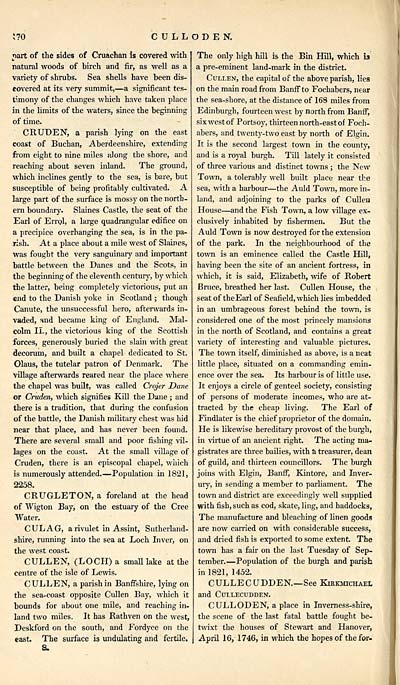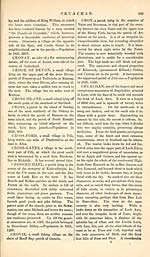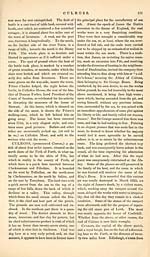Gazetteer of Scotland > Volume 1
(198) Page 170
Download files
Complete book:
Individual page:
Thumbnail gallery: Grid view | List view

170
CULLODEN.
nart of the sides of Cruachan is covered with
natural woods of birch and fir, as well as a
variety of shrubs. Sea shells have been dis-
covered at its very summit, — a significant tes-
timony of the changes which have taken place
in the limits of the waters, since the beginning
of time.
CRUDEN, a parish lying on the east
coast of Buchan, Aberdeenshire, extending
from eight to nine miles along the shore, and
reaching about seven inland. The ground,
which inclines gently to the sea, is bare, but
susceptible of being profitably cultivated. A
large part of the surface is mossy on the north-
ern boundary. Slaines Castle, the seat of the
Earl of Errol, a large quadrangular edifice on
a precipice overhanging the sea, is in the pa-
rish. At a place about a mile west of Slaines,
was fought the very sanguinary and important
battle between the Danes and the Scots, in
the beginning of the eleventh century, by which
the latter, being completely victorious, put an
end to the Danish yoke in Scotland ; though
Canute, the unsuccessful hero, afterwards in-
vaded, and became king of England. Mal-
colm II., the victorious king of the Scottish
forces, generously buried the slain with great
decorum, and built a chapel dedicated to St.
Olaus, the tutelar patron of Denmark. The
village afterwards reared near the place where
the chapel was built, was called Crojer Dane
or Cruden, which signifies Kill the Dane ; and
there is a tradition, that during the confusion
of the battle, the Danish military chest was hid
near that place, and has never been found.
There are several small and poor fishing vil-
lages on the coast. At the small village of
Cruden, there is an episcopal chapel, which
is numerously attended. — Population in 1821,
2258.
CRUGLETON, a foreland at the head
of Wigton Bay, on the estuary of the Cree
Water.
CULAG, a rivulet in Assint, Sutherland-
shire, running into the sea at Loch Inver, on
the west coast.
CULL EN, (LOCH) a small lake at the
centre of the isle of Lewis.
CULL EN, a parish in Banffshire, lying on
the sea-coast opposite Cullen Bay, which it
bounds for about one mile, and reaching in-
land two miles. It has Rathven on the west,
Deskford on the south, and Fordyce on the
east. The surface is undulating and fertile.
The only high hill is the Bin Hill, which is
a pre-eminent land-mark in the district.
Cullen, the capital of the above parish, lies
on the main road from Banff to Fochabers, near
the sea-shore, at the distance of 168 miles from
Edinburgh, fourteen west by north from Banff,
six west of Portsoy, thirteen north-east of Foch-
abers, and twenty-two east by north of Elgin.
It is the second largest town in the county,
and is a royal burgh. Till lately it consisted
of three various and distinct towns ; the New
Town, a tolerably well built place near the
sea, with a harbour — the Auld Town, more in-
land, and adjoining to the parks of Cullen
House — and the Fish Town, a low village ex-
clusively inhabited by fishermen. But the
Auld Town is now destroyed for the extension
of the park. In the neighbourhood of the
town is an eminence called the Castle Hill,
having been the site of an ancient fortress, in
which, it is said, Elizabeth, wife of Robert
Bnice, breathed her last. Cullen House, the
seat of theEarl of Seafield, which lies imbedded
in an umbrageous forest behind the town, is
considered one of the most princely mansions
in the north of Scotland, and contains a great
variety of interesting and valuable pictures.
The town itself, diminished as above, is a neat
little place, situated on a commanding emin-
ence over the sea. Its harbour is of little use.
It enjoys a circle of genteel society, consisting
of persons of moderate incomes, who are at-
tracted by the cheap living. The Earl of
Findlater is the chief proprietor of the domain.
He is likewise hereditary provost of the burgh,
in virtue of an ancient right. The acting ma-
gistrates are three bailies, with a treasurer, dean
of guild, and thirteen councillors. The burgh
joins with Elgin, Banff, Kintore, and Inver-
my, in sending a member to parliament. The
town and district are exceedingly well supplied
with fish, such as cod, skate, ling, and haddocks,
The manufacture and bleaching of linen goods
are now carried on with considerable success,
and dried fish is exported to some extent. The
town has a fair on the last Tuesday of Sep-
tember. — Population of the burgh and parish
in 1821, 1452.
CULLECUDDEN.— See Kirkmichael
and Cullecudden.
CULLODEN, a place in Inverness-shire,
the scene of the last fatal battle fought be-
twixt the houses of Stewart and Hanover,
April 16, 1746, in which the hopes of the for-
CULLODEN.
nart of the sides of Cruachan is covered with
natural woods of birch and fir, as well as a
variety of shrubs. Sea shells have been dis-
covered at its very summit, — a significant tes-
timony of the changes which have taken place
in the limits of the waters, since the beginning
of time.
CRUDEN, a parish lying on the east
coast of Buchan, Aberdeenshire, extending
from eight to nine miles along the shore, and
reaching about seven inland. The ground,
which inclines gently to the sea, is bare, but
susceptible of being profitably cultivated. A
large part of the surface is mossy on the north-
ern boundary. Slaines Castle, the seat of the
Earl of Errol, a large quadrangular edifice on
a precipice overhanging the sea, is in the pa-
rish. At a place about a mile west of Slaines,
was fought the very sanguinary and important
battle between the Danes and the Scots, in
the beginning of the eleventh century, by which
the latter, being completely victorious, put an
end to the Danish yoke in Scotland ; though
Canute, the unsuccessful hero, afterwards in-
vaded, and became king of England. Mal-
colm II., the victorious king of the Scottish
forces, generously buried the slain with great
decorum, and built a chapel dedicated to St.
Olaus, the tutelar patron of Denmark. The
village afterwards reared near the place where
the chapel was built, was called Crojer Dane
or Cruden, which signifies Kill the Dane ; and
there is a tradition, that during the confusion
of the battle, the Danish military chest was hid
near that place, and has never been found.
There are several small and poor fishing vil-
lages on the coast. At the small village of
Cruden, there is an episcopal chapel, which
is numerously attended. — Population in 1821,
2258.
CRUGLETON, a foreland at the head
of Wigton Bay, on the estuary of the Cree
Water.
CULAG, a rivulet in Assint, Sutherland-
shire, running into the sea at Loch Inver, on
the west coast.
CULL EN, (LOCH) a small lake at the
centre of the isle of Lewis.
CULL EN, a parish in Banffshire, lying on
the sea-coast opposite Cullen Bay, which it
bounds for about one mile, and reaching in-
land two miles. It has Rathven on the west,
Deskford on the south, and Fordyce on the
east. The surface is undulating and fertile.
The only high hill is the Bin Hill, which is
a pre-eminent land-mark in the district.
Cullen, the capital of the above parish, lies
on the main road from Banff to Fochabers, near
the sea-shore, at the distance of 168 miles from
Edinburgh, fourteen west by north from Banff,
six west of Portsoy, thirteen north-east of Foch-
abers, and twenty-two east by north of Elgin.
It is the second largest town in the county,
and is a royal burgh. Till lately it consisted
of three various and distinct towns ; the New
Town, a tolerably well built place near the
sea, with a harbour — the Auld Town, more in-
land, and adjoining to the parks of Cullen
House — and the Fish Town, a low village ex-
clusively inhabited by fishermen. But the
Auld Town is now destroyed for the extension
of the park. In the neighbourhood of the
town is an eminence called the Castle Hill,
having been the site of an ancient fortress, in
which, it is said, Elizabeth, wife of Robert
Bnice, breathed her last. Cullen House, the
seat of theEarl of Seafield, which lies imbedded
in an umbrageous forest behind the town, is
considered one of the most princely mansions
in the north of Scotland, and contains a great
variety of interesting and valuable pictures.
The town itself, diminished as above, is a neat
little place, situated on a commanding emin-
ence over the sea. Its harbour is of little use.
It enjoys a circle of genteel society, consisting
of persons of moderate incomes, who are at-
tracted by the cheap living. The Earl of
Findlater is the chief proprietor of the domain.
He is likewise hereditary provost of the burgh,
in virtue of an ancient right. The acting ma-
gistrates are three bailies, with a treasurer, dean
of guild, and thirteen councillors. The burgh
joins with Elgin, Banff, Kintore, and Inver-
my, in sending a member to parliament. The
town and district are exceedingly well supplied
with fish, such as cod, skate, ling, and haddocks,
The manufacture and bleaching of linen goods
are now carried on with considerable success,
and dried fish is exported to some extent. The
town has a fair on the last Tuesday of Sep-
tember. — Population of the burgh and parish
in 1821, 1452.
CULLECUDDEN.— See Kirkmichael
and Cullecudden.
CULLODEN, a place in Inverness-shire,
the scene of the last fatal battle fought be-
twixt the houses of Stewart and Hanover,
April 16, 1746, in which the hopes of the for-
Set display mode to: Large image | Transcription
Images and transcriptions on this page, including medium image downloads, may be used under the Creative Commons Attribution 4.0 International Licence unless otherwise stated. ![]()
| Gazetteers of Scotland, 1803-1901 > Gazetteer of Scotland > Volume 1 > (198) Page 170 |
|---|
| Permanent URL | https://digital.nls.uk/97426738 |
|---|
| Description | Volume I: Abbey to Glenartney. |
|---|---|
| Attribution and copyright: |
|
| Description | By Robert Chambers and William Chambers. Glasgow: Blackie & Son, 1838. 2 volumes. |
|---|---|
| Shelfmark | NF.1461.g.7 |
| Additional NLS resources: | |

